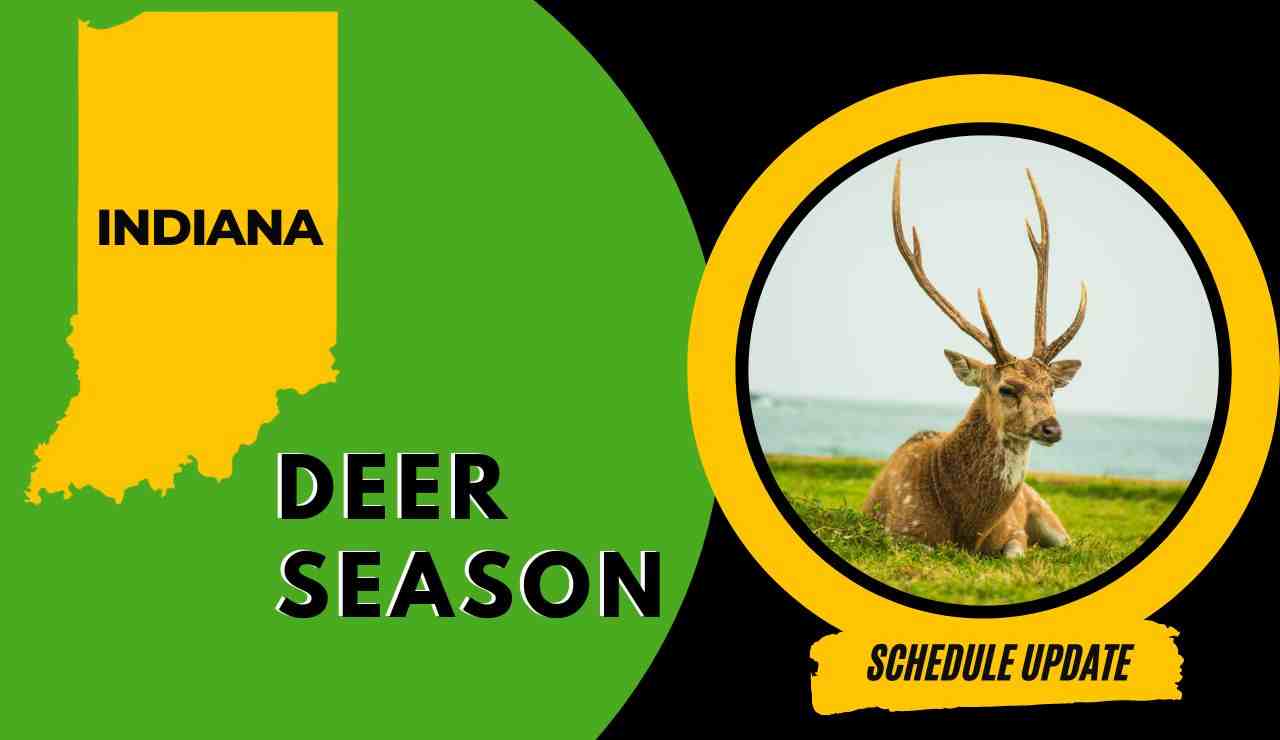Outdoor enthusiasts are already getting excited about the upcoming big game period in Indiana. The planned dates and rules for the 2023 season have been issued by the Indiana Department of Natural Resources (DNR), and hunters are anxiously preparing their plans for bagging the big one. To guarantee a safe and productive hunting season, all hunters must be educated about the many modifications and revisions to the hunting laws. In this page we’ll explore the proposed dates, rules, and other necessary details.
Indiana Deer Season
| Reduction Zone | 15-Sep – 31-Jan |
| Youth | 23-Sep – 24-Sep |
| Archery | 1-Oct – 7-Jan |
| Firearms | 18-Nov – 3-Dec |
| Muzzleloader | 9-Dec – 24-Dec |
Bag Limits
| Regular statewide | 1 antlered |
| reduction zone | 10 , of which only 1 can be antlered |
| Youth | Number of antlerless allowed by bonus county quota, plus 1 antlered |
| Archery | 1 antlerless and 1 of either sex |
| Firearms | 1 antlered |
| Muzzleloader | 1 of either sex |
| Military/refuge hunts | 1 per license |
Licenses
| Lisenses Types | Resident | Non Resident |
| Resident | $550 | |
| Deers Hunting | $39 | $240 |
| Bundle | $91 | $240 |
| Archery (Archery ) | $39 | $240 |
| Crossbow (Archery ) | $39 | $240 |
| Firearm (Buck Only – Firearms ) | $39 | $240 |
| Military/Refuge (federal military and national wildlife refuges only) | $39 | $240 |
| Muzzleloader (Muzzleloader only) | $39 | $240 |
| Reduction Zone (Reduction Zones only) | $39 | $39 |
| First Bonus Antlerless | $39 | $91 |
| – Second and Additional Resident Bonus Antlerless only5 | $24 | $39 |
For the Complete list of Licenses you review on the Indiana Department of Natural Resources Website
Tagging and Reporting a Kill
Tagging: Hunters are required to immediately complete a temporary paper tag with their name, address, the sex, license number (if applicable), and the date of the kill after killing a buck. Before the hunter leaves the deer, the tag must be fastened. As long as they have completed the paperwork and have it with them, hunters are not obliged to attach the tag on the deer as they pull it out of the field. However, until the fully completed temporary transit tag is fastened, hunters must retain immediate possession and visual contact with the corpse.
Reporting: Within 48 hours following the kill, hunters in Indiana must register their killed deer. The DNR’s CheckIN Game system offers three registration methods: online, over the phone (with a $3 cost), or by locating a check station or license vendor who can submit the information via CheckIN Game. The confirmation number hunters obtain after registering must be written down on a temporary transportation tag and kept with the deer until processing starts. It’s vital to remember that the head has to stay on the corpse until CheckIN Game registers it and issues a confirmation number.
Hunting Regulations
- Public or private land requires a permit, resident youth hunt/trap license, lifetime comprehensive hunting license, or lifetime comprehensive hunting/fishing license, unless exempt. Each permit allows one deer, same for the lifetime hunting license, resident youth hunt/trap license, and bundle.
- Archery period requires an archery, bundle, bonus antlerless, resident youth hunt/trap, lifetime comprehensive, or lifetime comprehensive hunting/fishing license. A hunter using a crossbow during archery season must also have a crossbow license.
- Firearms period requires a deer guns, bundle, bonus antlerless license, resident youth hunt/trap, lifetime comprehensive, or lifetime comprehensive hunting/fishing license. Importantly, muzzleloader licenses are invalid during deer weapons season.
- During a muzzleloader, hunters must have a current muzzleloader, bundle, a bonus antlerless, a resident youth hunt/trap, a lifetime comprehensive , or a lifetime comprehensive hunting/fishing license. Muzzleloader season does not allow weapons licenses.
- Deer license packages include all seasons except the reduction zone season. Hunters may kill three deer—two antlerless and one of each sex—with one license. This license counts towards the hunter’s all-state maximum of one antlered. The license is usable for crossbows, muzzleloaders, and other archery equipment in season. Any antlerless deer taken with a license bundle must count against the bag limit for bonus antlerless, archery, or muzzleloader, and the county quota still applies. On DNR territory, the additional antlerless license cannot be used against the bag limit. Hunters may contact the property or visit hunting.IN.gov.
- Have authorized hunting times that range from 30 minutes before sunrise to 30 minutes after sunset.
- Hunter orange is required during firearms, muzzleloader, reduction and youth seasons. Hunters using archery equipment are also regulated. If the hunter must wear hunter orange, the ground blind must be at least 144 square inches on each side. This applies to synthetic ground blinds less than four feet high. A blind flag does not satisfy the hunter-orange requirement on public or private property.
- Infrared sensors and electronic calls are illegal for deer hunting. Infrared sensors and computerized calls are also banned.
- Antlers must possess at least one antler that is at least three inches long.
- All deer hunting seasons allow tree stands. Permanent tree blinds are forbidden on state-owned or leased land. Portable tree stands are allowed on state-owned or leased territory and some national wildlife refuges. Tree stands may be left overnight from September to January at specified periods. Public areas prohibit fasteners that puncture trees more than half an inch. Public property tree stands must show the owner’s contact information or a DNR Customer Identification Number.
- Snares, salt, and bait lure animals for hunting. They’re allowed since artificial decoys don’t utilize lures or bait. Except for tracking wounded deer on a leash, dogs cannot hunt deer. Tree stands are allowed, although permanent tree blinds are forbidden on state-owned or leased land. Portable tree stands must be identified with the owner’s name on state-owned or leased property, U.S. Forest Service territory, and some national wildlife refuges.
- Reduction zones must correctly report deer in CheckIN Game. They must indicate whether the counts toward the zone bag limit and if it was taken in a reduction zone. To use the reduction zone to take a second buck or complete the antlerless bag limit, the hunter must count their bag against the zone bag limit. Hunters who hunt in a reduction zone without a license should indicate that the deer will not count against the bag limit.
- Shotguns, pistols, legal-caliber rifles, muzzleloaders, and air rifles may be used during the firearms. Muzzleloader season allows just muzzleloaders. Hunters may carry several legal firearms during guns, youth, and reduction zone seasons if local laws allow it. Suppressor-equipped guns may kill under federal law. Hunters must use legal, state- and federally-authorized weapons to avoid legal issues.
- Indiana Code 35-47-2-1 allows hunters to carry pistols without licenses. Handguns are only authorized during firearms season, muzzleloading season, and deer reduction zones where municipal laws allow it. Hunters must also observe DNR handgun laws. These restrictions may regulate ammunition caliber and type as well as sights. Before using this method, hunters must check pistol deer hunting laws.
Frequently Asked Questions
How do I report a harvested deer in Indiana?
Within 48 hours of harvest, every deer taken in Indiana must be reported at an on-site check station, online via your Indiana Fish & Wildlife Account, by phone at 1-800-419-1326, or through your Indiana Fish & Wildlife Account. The phone service costs $3 and may only be paid using a Visa or Mastercard.
Can non-residents hunt deer in Indiana?
Yes, deer hunting is permitted in Indiana for non-residents. They must, however, buy a non-resident hunting license.
What should you do if you want to retrieve a deer that went onto a neighboring property after you shot it?
You must get permission from the owners before entering their property if you wish to rescue a deer that you shot and it wanders into a nearby property. It’s better to have written consent; if you don’t, call your neighborhood conservation officer at (812-837-9536) for assistance.
How to dispose of lawfully taken wild animal carcasses and parts?
Deer and other wild animal corpses that have been legally captured are not to be burned or dumped in bodies of water. Instead, they must be disposed of humanely. It’s also not advised to leave them out in the open without the landowner’s consent. Putting corpses and undesirable animal parts in bags and throwing them in the garbage to be taken to a landfill is the easiest method to get rid of them.
- California Deer Hunting Guide: Seasons, Rules, Permits, and More - 26 June 2024
- Arkansas Deer Season 2024 [Schedules, Licenses, Bag Limits & More!] - 26 June 2024
- 2024 Arizona Deer Season New Dates & Rules! - 25 June 2024




